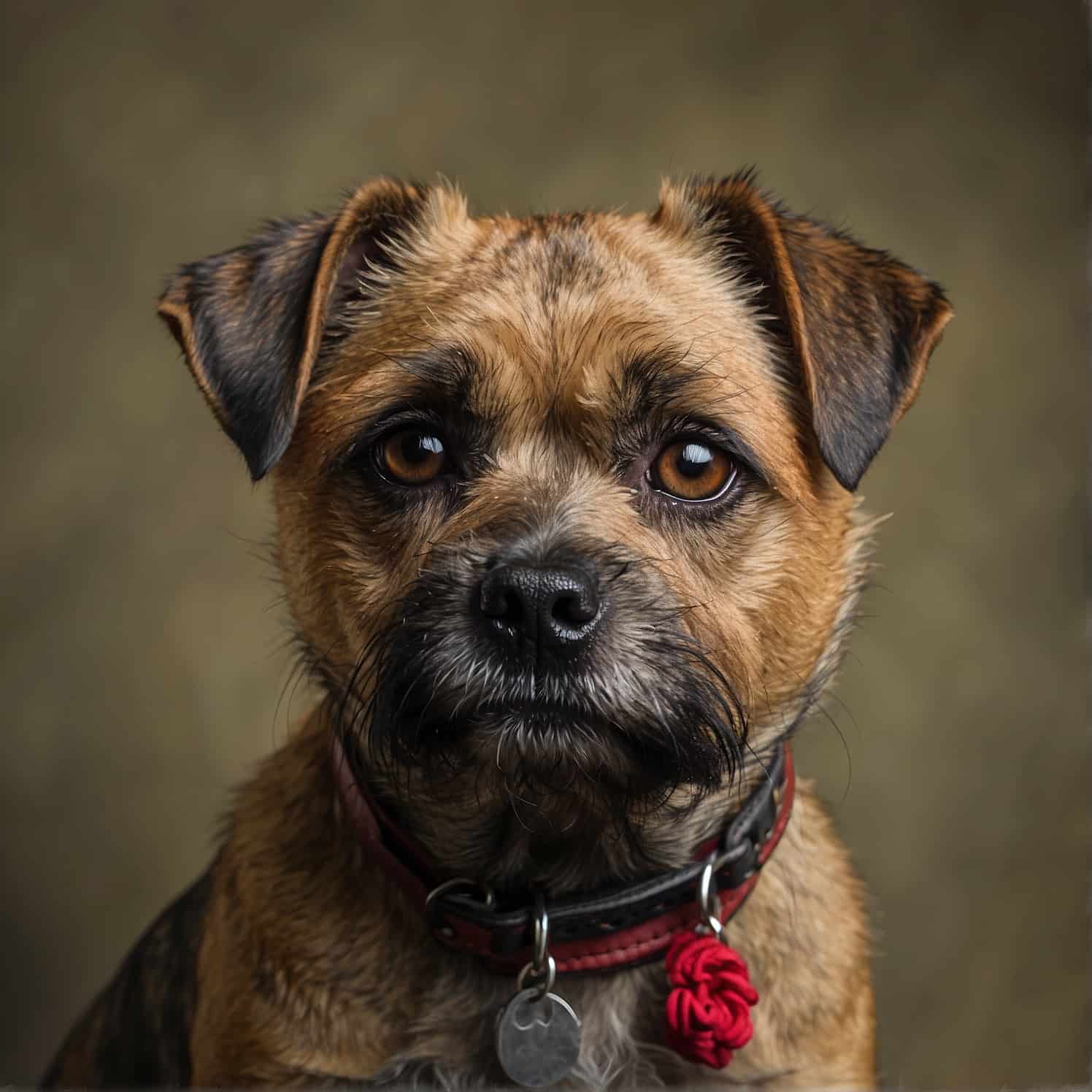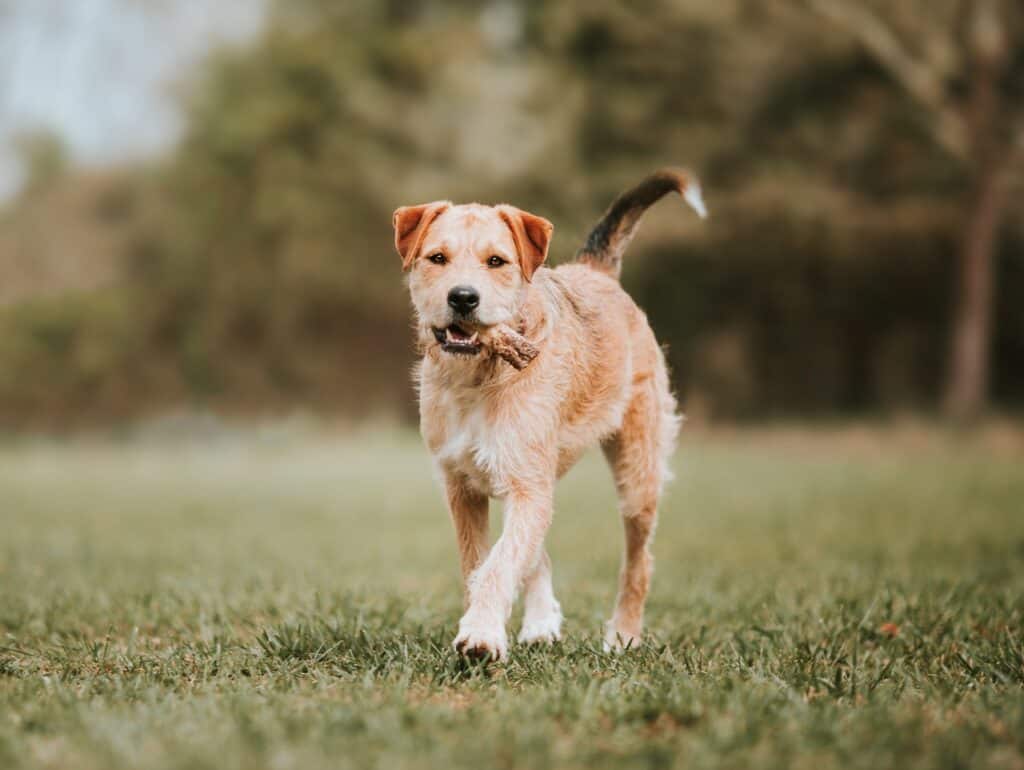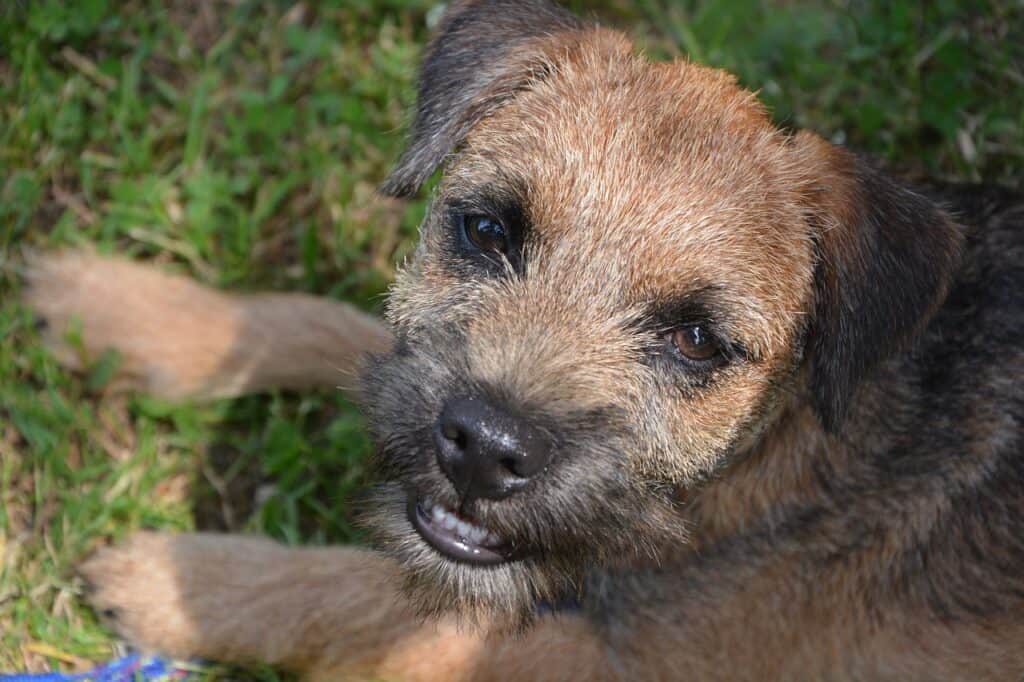Step into the world of Border Terriers, a breed known for its tenacity and friendly demeanor. Explore their history, delve into the care they deserve, and uncover the endearing traits that make Border Terriers cherished members of countless families.

| Category (Explanation) | Breed Information |
|---|---|
| Year of Breed Conception | 18th century |
| Country of Origin | United Kingdom |
| Weight (lbs & kg) (Male) | 13-15.5 lbs (6-7 kg) |
| Weight (lbs & kg) (Female) | 11.5-14 lbs (5-6.5 kg) |
| Coat Type | Harsh, dense double coat |
| Color Variations | Red, blue and tan, grizzle and tan |
| Shedding Level (Low, Moderate, High) | Low to Moderate |
| Height (cm & in) | 10-11 inches (25-28 cm) |
| Breed Size | Small |
| Trainability (Low, Moderate, High) | High |
| Mental Needs (Low, Moderate, High) | Moderate |
| Intelligence Level (Low, Moderate, High) | High |
| Energy Level (Low, Moderate, High) | Moderate |
| Agility (Low, Moderate, High) | High |
| Loyalty (Low, Moderate, High) | High |
| Playfulness (Low, Moderate, High) | High |
| Exercise Needs | Regular exercise and playtime |
| Guarding Proficiency (Low, Moderate, High) | Moderate |
| Sociability with Children (Low, Moderate, High) | High |
| Barking Level (Low, Moderate, High) | Moderate |
| Digging Tendency (Low, Moderate, High) | Moderate |
| Destructive Behavior (Low, Moderate, High) | Low |
| Drooling Level (Low, Moderate, High) | Low |
| Obedience Level (Low, Moderate, High) | High |
| Apartment Friendly (Yes/No) | Yes, with proper exercise and mental stimulation |
| Inherent Prey Drive | High |
| Physical Risk to Others (Low, Moderate, High) | Low |
| Travel Fatality Risk (Low, Moderate, High) | Low |
| Allergen Potential | Low |
| Health Concerns (List of Common Health Concerns) | Hip Dysplasia, Heart Conditions, Allergies |
| Average Life Expectancy (Life Expectancy in Years) | 12-15 years |
Woof Mastery is reader supported and our articles may contain affiliate links.
Instead of running third party ads that we have no control of we only use links from high-quality companies we are directly partnered with. Making use of these links come at no cost to you our reader, and in many cases have the extra benefit of discounted rates or sign up bonuses.
If you’re interested you can read more about our affiliate policy here.
We appreciate your support and always insure that the products and services we recommend are high-quality, helpful and relevant to the subject at hand!
The Border Terrier has a history rooted in the border region of England and Scotland. Bred as tenacious and friendly companions, they were valued for their ability to work alongside hunters and farmers. Border Terriers have maintained their tenacity and endearing nature throughout history. Their lively and spirited personality has endeared them to families worldwide. Today, Border Terriers continue to be known for their tenacity and friendly demeanor, making them exceptional companions for those who appreciate their enduring spirit.

Border Terriers are special for their tenacity and friendly demeanor. Their tenacious spirit and lovable nature make them unique among terrier breeds. Explore their history, delve into the care they deserve, and uncover the endearing traits that set Border Terriers apart as cherished members of countless families. Their remarkable qualities make them special companions.
Border Terriers have a traditional role rooted in their tenacity and friendly demeanor. Originating in the border regions of England and Scotland, these small but spirited dogs were primarily bred for hunting foxes and other small game. Their primary duty was to work alongside hunters, flushing out foxes from their dens. Their agile and determined nature made them excellent at this task. While their historical role as hunters is not as prominent today, Border Terriers continue to display their endearing qualities as beloved family members and are known for their energetic and friendly nature.
Border Terriers have tenacious and endearing personalities. They are known for their friendly and spirited demeanor. These terriers are full of affection and make great companions. They are independent thinkers and require training and socialization to be well-rounded family pets. With the right approach, they are loving and loyal companions.
Border Terriers are known for their tenacious and friendly demeanor. They are typically affectionate with their families and enjoy an active lifestyle. However, their terrier nature can sometimes lead to stubbornness. Early training and socialization are essential to ensure they exhibit well-rounded temperaments. They may have a strong prey drive, and their love for digging is a characteristic to be managed.
Border Terriers are small, agile dogs with a wiry, dense, and weather-resistant coat that can come in various colors. They have a small, well-proportioned head with a dark nose, expressive eyes, and V-shaped ears that fold forward. Border Terriers have a short, straight tail and strong, straight legs. They have a confident and friendly gait, reflecting their tenacity and endearing nature.
Border Terriers typically have a dense, wiry coat that can come in various colors. Common coat colors for Border Terriers include red, grizzle and tan, or blue and tan. Their coats are weather-resistant, which helps them excel as working terriers in challenging conditions.
Border Terriers typically have a dense and wiry coat. Their most common coat color is red, often with a grizzle saddle, but they can also be seen in other colors like blue and tan, grizzle and tan, or wheaten.
Border Terriers have a low shedding level. They have a dense, wiry coat that benefits from regular grooming. Brushing helps manage shedding and keeps their coat in good condition. While they shed minimally, attention to their coat’s texture and occasional grooming sessions contribute to reduced shedding. Overall, Border Terriers are considered to be a breed with low maintenance in terms of shedding.
Border Terriers have a dense, wiry coat that requires regular grooming. Grooming habits for Border Terriers include:
Border Terriers have a high activity level. These energetic and intelligent terriers thrive on physical exercise and mental stimulation. Daily walks, playtime, and engaging activities are essential to keep them happy. Border Terriers may excel in agility and other canine sports. Their strong prey drive makes interactive play, such as fetch, a favorite activity. Regular exercise is crucial to prevent boredom-related behaviors, and providing them with puzzle toys and challenging activities helps keep their minds active.
Border Terriers are highly intelligent and trainable dogs. They are known for their problem-solving abilities and agility. Border Terriers excel in various activities, including obedience training and agility trials. Their intelligence, coupled with a friendly and adaptable nature, makes them quick learners and well-suited for tasks that require mental stimulation. Positive reinforcement methods work effectively with Border Terriers, and they enjoy engaging in activities with their owners.
Border Terriers are known for their intelligence and require mental stimulation. Engage them in activities like puzzle toys, interactive games, and obedience training to keep their minds active. Regular social interaction is crucial, as they enjoy companionship. Incorporate variety into their routines to prevent boredom, and consider agility or other dog sports to challenge their problem-solving skills.
Enter The Woof Mastery

Before bringing a Border Terrier into your home, it’s crucial to understand their needs and characteristics. These dogs are known for their intelligence, energy, and friendly demeanor. Regular mental and physical stimulation is essential to keep them happy and prevent boredom. Training and socialization should start early to ensure they grow into well-mannered companions. Potential owners should be prepared for grooming needs and committed to providing a loving, active environment for these intelligent and affectionate dogs.
Border Terriers, with their intelligent and adaptable nature, generally pose a low risk to others. Proper socialization and training contribute to positive interactions. Responsible ownership, early exposure to various environments, and understanding individual temperament play crucial roles in ensuring a well-behaved Border Terrier.
Border Terriers are known for their friendly and outgoing nature. They can form strong bonds with children and enjoy playtime. Supervision is important to ensure positive interactions. Early socialization and positive reinforcement training contribute to a positive relationship between the dog and children.
Border Terriers may have mixed responses to water. Some individuals may enjoy swimming, while others may not be as comfortable. If you plan to introduce them to water, do so gradually and observe their comfort level. Always prioritize safety and use a canine life vest if needed, especially in situations where they may be at risk of fatigue.
Remember that Border Terrier puppies, like all puppies, are eager to please and learn. Positive and consistent training practices will help them become well-behaved, obedient, and happy adult dogs. Building a strong and trusting bond with your puppy through training is a rewarding experience for both you and your canine companion.
Border Terriers may exhibit moderate barking tendencies. They are alert and may bark to alert their owners or express themselves. Early training and socialization can help manage their barking behavior and teach them appropriate times to vocalize.
Border Terriers are adaptable and can thrive in various living conditions. They do well in homes with yards for play and exploration. Regular exercise and mental stimulation are important for their well-being. Border Terriers can adapt to apartment living with consistent exercise. They are social dogs that enjoy being part of the family. Early training and socialization contribute to a well-behaved Border Terrier.
Border Terriers are generally adaptable to travel conditions. Ensure they are securely restrained in the vehicle using a crate or a suitable seatbelt harness. Monitor for signs of stress or discomfort, and provide breaks for exercise. Familiar items and positive reinforcement can help create a positive travel experience for Border Terriers. Plan for regular breaks during long journeys to ensure their well-being.
Border Terriers may be prone to specific health concerns. While not all individuals will experience these issues, it’s essential for Border Terrier owners to be aware of potential health problems and work with veterinarians to maintain their pets’ well-being. Common health concerns in Border Terriers include:
Regular veterinary check-ups, a balanced diet, proper exercise, and responsible breeding practices can contribute to the overall well-being of Border Terriers. Owners should collaborate with veterinarians to address any health concerns promptly.
Proper nutrition is crucial for the health and well-being of Border Terriers. Here are some nutritional habits and best practices to consider for this breed:
Breed-Specific Laws (BSL): Border Terriers may be subject to breed-specific laws (BSL) in certain areas. These laws are often enacted at the local or municipal level and can vary widely from one jurisdiction to another.
Types of Restrictions: The specific restrictions imposed on Border Terriers under BSL can include mandatory spaying/neutering, special licensing, liability insurance requirements, muzzling in public, and, in some cases, bans on ownership. The severity of these restrictions depends on local regulations.
Rationale for BSL: BSL is typically implemented based on concerns about public safety and perceived risks associated with specific breeds, often due to incidents involving dog attacks. While Border Terriers are not inherently aggressive, they can be affected by BSL due to their physical resemblance to breeds that are sometimes included in these laws.
Controversy: It’s important to note that BSL is a controversial topic. Critics argue that it unfairly targets breeds rather than addressing individual dog behavior and that responsible ownership and training should be emphasized instead of breed-specific restrictions.
Local Regulations: To determine if there are breed-specific laws or restrictions regarding Border Terriers in your area, you should check with your local animal control or government authorities. Be aware of and comply with any local regulations to ensure that you are in compliance with the law while owning a Border Terrier.
Woof Mastery is reader supported and our articles may contain affiliate links.
Instead of running third party ads that we have no control of we only use links from high-quality companies we are directly partnered with. Making use of these links come at no cost to you our reader, and in many cases have the extra benefit of discounted rates or sign up bonuses.
If you’re interested you can read more about our affiliate policy here.
We appreciate your support and always insure that the products and services we recommend are high-quality, helpful and relevant to the subject at hand!
Myth 1: Border Terriers are not intelligent.
Myth 2: They need excessive exercise.
Myth 3: They are not good with children.
Myth 4: They are too independent.
Myth 5: They are not suitable for apartment living.
Famous Border Terrier owners include:
Queen Elizabeth II: The Queen has been known to have a fondness for Border Terriers. She has owned several throughout her reign, including Dookie, Rozavel Golden Eagle, and others.
The Border Terrier holds cultural significance in several domains:
The Border Terrier, valued for its intelligence and agility, does not have a single most famous historical owner. However, Border Terriers have been popular among dog owners, particularly those who engage in dog sports and activities.
Border Terriers, like many breeds, have faced challenges over the years. Some notable challenges include:
The Border Terrier is a working terrier breed that originated in the border region between England and Scotland. It is believed to have been developed from a combination of terrier breeds, including:
Border Terriers, with their intelligence and friendly disposition, are ideal family companions. Known for their loyalty and adaptability, they seamlessly integrate into various living conditions. Their moderate grooming needs and manageable size make them suitable for families. Border Terriers excel in activities and training, showcasing their agility and enthusiasm. Their affectionate nature and compatibility with children make them valued additions to households seeking a playful and devoted companion.